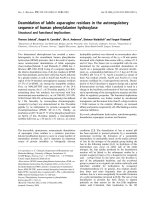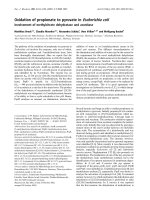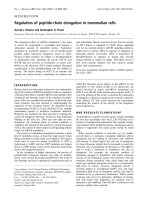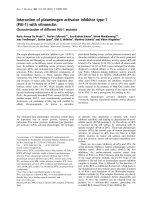Báo cáo y học: "Lack of association of a variable number of aspartic acid residues in the asporin gene with osteoarthritis susceptibility: case-control studies in Spanish Caucasians" potx
Bạn đang xem bản rút gọn của tài liệu. Xem và tải ngay bản đầy đủ của tài liệu tại đây (86.5 KB, 4 trang )
Open Access
Available online />Page 1 of 4
(page number not for citation purposes)
Vol 8 No 3
Research article
Lack of association of a variable number of aspartic acid residues
in the asporin gene with osteoarthritis susceptibility: case-control
studies in Spanish Caucasians
Julio Rodriguez-Lopez
1
, Manuel Pombo-Suarez
1
, Myriam Liz
1
, Juan J Gomez-Reino
1,2
and
Antonio Gonzalez
1
1
Laboratorio de Investigacion 2 and Rheumatology Unit, Hospital Clinico Universitario de Santiago, Santiago de Compostela, Spain
2
Department of Medicine, University of Santiago de Compostela, Spain
Corresponding author: Antonio Gonzalez,
Received: 21 Dec 2005 Revisions requested: 18 Jan 2006 Revisions received: 3 Feb 2006 Accepted: 14 Feb 2006 Published: 10 Mar 2006
Arthritis Research & Therapy 2006, 8:R55 (doi:10.1186/ar1920)
This article is online at: />© 2006 Rodriguez-Lopez et al.; licensee BioMed Central Ltd.
This is an open access article distributed under the terms of the Creative Commons Attribution License ( />),
which permits unrestricted use, distribution, and reproduction in any medium, provided the original work is properly cited.
Abstract
A recent genetic association study has identified a microsatellite
in the coding sequence of the asporin gene as a susceptibility
factor for osteoarthritis (OA). Alleles of this microsatellite
determine the variable number of aspartic acid residues in the
amino-terminal end of the asporin protein. Asporin binds directly
to the growth factor transforming growth factor beta and inhibits
its anabolic effects in cartilage, which include stimulation of
collagen and aggrecan synthesis. The OA-associated allele,
with 14 aspartic acid residues, inhibits the anabolic effects of
transforming growth factor beta more strongly than other
asporin alleles, leading to increased OA liability. We have
explored whether the association found in several cohorts of
Japanese hip OA and knee OA patients was also present in
Spanish Caucasians. We studied patients that had undergone
total joint replacement for primary OA in the hip (n = 303) or the
knee (n = 188) and patients with hand OA (n = 233), and we
compared their results with controls (n = 294) lacking overt OA
clinical symptoms. No significant differences were observed in
any of the multiple comparisons performed, which included
global tests of allele frequency distributions and specific
comparisons as well as stratification by affected joint and by sex.
Our results, together with reports from the United Kingdom and
Greece, indicate that the stretch of aspartic acid residues in
asporin is not an important factor in OA susceptibility among
European Caucasians. It remains possible that lifestyle,
environmental or genetic differences allow for an important
effect of asporin variants in other ethnic groups as has been
reported in the Japanese, but this should be supported by
additional studies.
Introduction
Current concepts in osteoarthritis (OA) imply an imbalance of
cartilage anabolic and catabolic processes in response to
mechanical stress with the participation of inflammatory medi-
ators [1]. Recent investigation has also shown that genetic
factors account for a substantial portion of OA etiology [2,3].
These two considerations contribute to the interest of a recent
report showing that a variant of asporin (ASPN) is a suscepti-
bility factor for OA [4]. This association points to a defect in
the anabolic side of cartilage homeostasis, identifies ASPN
and transforming growth factor beta as important molecular
players in this process, and suggests that regulatory genetic
variants are important in OA susceptibility [5,6].
ASPN is a new member of the small leucin-rich proteoglycan
subfamily of proteins [7,8] that is expressed at low levels in
normal cartilage but that is notably increased in OA cartilage
[4]. Variant ASPN proteins are due to a microsatellite in the
ASPN coding sequence that determines a variable number of
aspartic acid (D) residues in the amino terminal region. The
D14 allele is associated with increased OA susceptibility in
the Japanese (odds ratio = 1.66–2.49, depending on the
cohort) [4] due to its strong inhibition of the cartilage anabolic
effects induced by transforming growth factor beta [4]. Given
the significance of these results, we explored the ASPN effect
in Spanish patients with severe knee or hip OA or with hand
OA, but we did not find association. This result is similar to
ASPN = asporin; D = aspartic acid; OA = osteoarthritis; PCR = polymerase chain reaction; THR = total hip replacement; TKR = total knee replace-
ment.
Arthritis Research & Therapy Vol 8 No 3 Rodriguez-Lopez et al.
Page 2 of 4
(page number not for citation purposes)
findings in UK Caucasians [9] and in the Greek population
[10], and together the observations indicate that the ASPN
microsatellite does not have a significant effect on OA suscep-
tibility in European Caucasians.
Materials and methods
Patients and controls
Patients were selected from consecutive patients undergoing
total hip replacement (THR) or total knee replacement (TKR)
and patients complaining of hand OA that were followed in the
Rheumatology Unit. THR and TKR patients were included only
if surgery has been performed at ages ranging from 55 to 75
years and if a rheumatologist considered them to suffer from
severe primary OA after compatible evaluation and exclusion
of the following confounding factors: inflammatory, infectious,
traumatic or congenital joint pathology and lesions due to crys-
tal deposition or osteonecrosis. Evaluation of patients
included an interview with each patient specifically for this
study and a review of the clinical history and a review of radio-
graphs. Analysis of synovial fluid was not a requisite. Obesity
and occupational strain were not considered exclusion
causes. Patients with hand OA were required to fulfill Ameri-
can College of Rheumatology classification criteria [11].
The final numbers of patients in each group were 303 THR
patients (183 women, 120 men), 188 TKR patients (153
women, 35 men) and 232 hand OA patients (205 women, 27
men). We recruited controls among subjects older than 55
years undergoing preoperative workup for elective surgeries
other than joint surgery. We restricted analysis to the 35.5%
of controls (294/828 donors, 115 women and 179 men) that
did not show clinical manifestations of OA (absence of chronic
pain or restriction of mobility in the two years before recruit-
ment, no hand enlargements or deformities, and no previous
medical evaluation as OA). Radiographic exploration was not
performed in controls.
This study was approved by the Ethical Committee for Clinical
Research of Galicia and all cases and controls gave their writ-
ten informed consent to participate. All participants were of
Spanish ancestry and resided in the reference area of the hos-
pital.
Genotyping
Peripheral blood DNA was used to genotype the D-repeat
microsatellite by PCR with the primers 5'-FAM-TGGCTTTGT-
GCTCTGCCAAACC-3' and 5'-TCTGAGCAATGTA-
CAACTCGTG-3'. The size of the fluorescence-labeled
products was determined by capillary electrophoresis on an
ABI prism 3100 Avant Genetic Analyzer (Applied Biosystems,
Foster City, CA, USA). Several samples with different geno-
Table 1
Frequencies of the asporin microsatellite alleles in Spanish controls and each of the patient groups
Allele
Group D12 D13 D14 D15 D16 D17 D18 D19
Controls
All controls (n = 294) 31(5.3) 248 (42.2) 74 (12.6) 150 (25.5) 55 (9.3) 12 (2.0) 10 (1.7) 8 (1.3)
Males (n = 179) 22 (6.15) 154 (43.0) 48 (13.4) 90 (25.1) 29 (8.1) 5 (1.4) 6 (1.7) 4 (1.1)
Females (n = 115) 9 (3.9) 94 (40.9) 26 (11.3) 60 (26.1) 26 (11.3) 7 (3.0) 4 (1.7) 4 (1.7)
Total hip replacement
All patients (n = 303) 22 (3.6) 262 (43.3) 59 (9.7) 156 (25.7) 68 (11.2) 13 (2.1) 13 (2.1) 13(2.1)
Males (n = 120) 7 (2.9) 105 (43.7) 25 (10.4) 64 (26.7) 20 (8.3) 6 (2.5) 9 (3.7) 4 (1.7)
Females (n = 183) 15 (4.1) 157 (42.9) 34 (9.3) 92 (25.1) 48 (13.1) 7 (1.9) 4 (1.1) 9 (2.5)
Total knee replacement
All patients (n = 188) 14 (3.7) 156 (41.5) 56 (14.9) 93 (24.7) 30 (7.9) 14 (3.7) 7 (1.8) 6 (1.6)
Males (n = 35) 3 (4.3) 36 (51.4) 11 (15.7) 14 (20.0) 4 (5.7) 0 (0.0) 2 (2.8) 0 (0.0)
Females (n = 153) 11 (3.6) 120 (39.2) 45 (14.7) 79 (25.8) 26 (8.5) 14 (4.6) 5 (1.6) 6 (2.0)
Hand osteoarthritis
All patients (n = 232) 16 (3.4) 209 (44.8) 57 (12.2) 113 (24.2) 46 (9.9) 13 (2.8) 8 (1.7) 4 (0.8)
Males (n = 27) 2 (3.7) 18 (33.3) 6 (11.1) 19 (35.2) 6 (11.1) 0 (0.0) 2 (3.7) 1(1.8)
Females (n = 205) 14 (3.4) 189 (46.1) 51 (12.4) 94 (22.9) 40 (9.8) 13 (3.2) 6 (1.5) 3 (0.7)
Values presented the number of alleles (%).
Available online />Page 3 of 4
(page number not for citation purposes)
types were sequenced to test the accuracy of genotyping with
the Big Dye Ready Reaction Kit (Applied Biosystems).
Statistical analysis
Allele frequencies and their 95% confidence intervals were
calculated. Comparison of allele frequencies was carried out
using the 2 × n contingency table after collapsing columns
with low frequency, as implemented in the T2 option of the
Clump software that follows a Monte Carlo approach [12].
Post-hoc power was determined with the GPower software
[13] for each comparison of the D14 and D13 allelic frequen-
cies between patients and controls.
Results and discussion
This study explored whether the sound association between
the ASPN microsatellite and OA in the Japanese population
[4] was also present in the Spanish population. We therefore
searched for evidence of association in multiple ways. First,
the allelic frequency distribution of the microsatellite was com-
pared between the three groups of patients separated by the
affected joint and the controls (Table 1). None of these three
comparisons showed differences. All P values were far larger
than the threshold for significance: TKR patients versus con-
trols, P = 0.6; THR patients versus controls, P = 0.5; and hand
OA patients versus controls, P = 0.9.
Similar results were obtained after stratifying by sex (Table 1).
Female patients and controls had similar allele frequencies
(TKR patients versus controls, P = 0.9; THR patients versus
controls, P = 0.9; and hand OA patients versus controls, P =
0.8), as well as male patients and controls (TKR patients ver-
sus controls, P = 0.6; THR patients versus controls, P = 0.3;
hand OA patients versus controls, P = 0.4). We also pooled
data from TKR and THR patients as both patient groups were
associated with ASPN in the Japanese population, but even
for this larger group there was no difference with the controls
(P = 0.8). A similar result was observed if all the OA patients
were taken together (THR + TKR + hand OA = 723 patients,
P = 0.8).
These results are in clear contrast with the association
described in several cohorts of Japanese subjects, where the
frequency distributions of this microsatellite were consistently
different between patients with knee OA or hip OA and con-
trols [4], but they were similar to recent results in the UK pop-
ulation [9] and the Greek population [10].
The differences in the ASPN microsatellite frequency distribu-
tions reported in the Japanese study were due mainly to an
increased frequency of the D14 allele and to a lesser extent
due to a decreased frequency of the D13 allele in OA patients
[4]. The Greek study also found a significant decrease of the
D13 allele in TKR patients but there was no change in the D14
frequency. The UK study did not find significant differences
but observed a tendency in the same sense as the Japanese
study: an increase of the D14 allele and a decrease of the D13
allele in THR and TKR patients [9]. We therefore specifically
tested these two alleles for differences in our subjects (Table
2).
No differences were detected in the D14 allele frequencies
between controls and TKR patients, THR patients, both TKR
and THR patients together, or hand OA patients (this later
group had not been included in previous studies). We did not
even observe a tendency to a higher frequency of the D14
allele in patients. The same pattern was found when this anal-
ysis was repeated after stratifying by sex. In the same way, the
frequency of the D13 allele was similar in all patient groups
and in controls (Table 2) and no difference was observed after
stratifying by sex. Finally, as the most sensitive test, we consid-
ered only the D13 and the D14 alleles and compared their rel-
ative frequencies in each patient group with their frequencies
in the controls, but again no differences were found (Table 2).
Even with this later comparison that gave the largest differ-
ence in the Japanese population, we did not find evidence of
association of OA with the ASPN microsatellite in our patients.
The present study has enough post-hoc power (>0.8), how-
ever, to detect a D14 effect of the size found in the Japanese
[4], with P < 0.05. The power for the comparisons of THR
Table 2
Comparisons of the D14 and D13 allelic frequencies of the asporin microsatellite between Spanish osteoarthritis patients and
controls represented as P values
Comparison
Group D14 versus others D13 versus others D14 versus D13
Total hip replacement (n = 303) 0.12 0.71 0.15
Total knee replacement (n = 188) 0.31 0.83 0.37
Total hip replacement + total knee
replacement (n = 597)
0.61 0.88 0.63
Hand osteoarthritis (n = 233) 0.86 0.38 0.65
Arthritis Research & Therapy Vol 8 No 3 Rodriguez-Lopez et al.
Page 4 of 4
(page number not for citation purposes)
patients versus controls and TKR patients versus controls is
0.83 and 0.94 for the D14 allele frequencies and is 0.90 and
0.98 for the D14 versus D13 frequencies, respectively. The
comparison lacks power to detect a decrease of the D13 allele
in OA patients, similar to the Japanese study (power is 0.16 for
the comparison of THR patients versus controls and is 0.29 for
the comparison of TKR patients versus controls), probably due
to the weak effect of this allele (odds ratio = 0.84 both for hip
OA and knee OA in the Japanese population).
Our results were similar to the UK study [9] except for a signif-
icant increase of the D14 allele in UK THR males that did not
persist after correction for the multiple tests performed. In con-
trast, our patients showed a nonsignificant decrease of this
allele in THR males (10.4%, 95% confidence interval 3.4–
17.4% in THR males versus 13.4%, 95% confidence interval
5.6–21.2% in male controls). The D14 allele was also similar
in Greek TKR patients and controls [10]. The Greek TKR
patients, however, showed significantly increased frequencies
of the D15 and D18 alleles, which were not found in our study
(Table 1) or in the other two larger studies, and which did not
remain significant after accounting for the multiple compari-
sons performed. The overall results therefore indicate that the
ASPN microsatellite is not associated with OA susceptibility in
European Caucasians. Discrepancies between the Japanese
and Caucasians could be multifactorial, involving differences
in disease phenotype, in lifestyle, and in environmental and
genetic factors.
Conclusion
There was no detectable effect of variation in the number of D
residues in ASPN in hip OA, knee OA or hand OA susceptibil-
ity in Spanish Caucasians. This result reinforces the overall
lack of association reported in other studies in Caucasians.
The association between variation in the number of D residues
and OA described in the Japanese study is robust, however,
and is not refuted by these studies, but it will require confirma-
tion in the same ethnic population. Therefore, although it
remains possible that ASPN could be a crucial modulator in
OA by fine-tuning transforming growth factor beta in the repair
of damaged cartilage, this effect will be limited to some ethnic
groups or environmental settings.
Competing interests
The authors declare that they have no competing interests.
Authors' contributions
All authors contributed to the final manuscript. In addition, JR-
L genotyped the samples and participated in the design and
analysis of the study, MP-S, ML and JJG-R evaluated the
patients, and AG coordinated the study and participated in its
design and analysis.
Acknowledgements
The authors thank sample donors for their collaboration. They thank also
Yolanda Lopez-Golan and Fina Meijide for their help in recruiting study
participants. Marta Picado and Cristina Fernandez provided outstanding
technical assistance. This project was supported by grant PI02/0713
form the Instituto de Salud Carlos III (Spain) with participation of funds
from FEDER (European Union), and by a grant of the Fundacion Pedro
Barrie de la Maza (A Corunna, Spain). JR-L is the recipient of a scholar-
ship of the National Program for the Training of University Professors of
the Spanish Ministry of Education. AG was supported by the Instituto de
Salud Carlos III (Spain).
References
1. Malemud CJ, Islam N, Haqqi TM: Pathophysiological mecha-
nisms in osteoarthritis lead to novel therapeutic strategies.
Cells Tissues Organs 2003, 174:34-48.
2. Spector TD, MacGregor AJ: Risk factors for osteoarthritis:
genetics. Osteoarthritis Cartilage 2004, 12(Suppl A):S39-S44.
3. Zhang W, Doherty M: How important are genetic factors in
osteoarthritis? Contributions from family studies. J Rheumatol
2005, 32:1139-1142.
4. Kizawa H, Kou I, Iida A, Sudo A, Miyamoto Y, Fukuda A, Mabuchi
A, Kotani A, Kawakami A, Yamamoto S, et al.: An aspartic acid
repeat polymorphism in asporin inhibits chondrogenesis and
increases susceptibility to osteoarthritis. Nat Genet 2005,
37:138-144.
5. Loughlin J: Polymorphism in signal transduction is a major
route through which osteoarthritis susceptibility is acting.
Curr Opin Rheumatol 2005, 17:629-633.
6. Coburn B: Osteoarthritis? Try asporin. Clin Genet 2005,
67:394-395.
7. Lorenzo P, Aspberg A, Onnerfjord P, Bayliss MT, Neame PJ, Hein-
egard D: Identification and characterization of asporin. a novel
member of the leucine-rich repeat protein family closely
related to decorin and biglycan. J Biol Chem 2001,
276:12201-12211.
8. Henry SP, Takanosu M, Boyd TC, Mayne PM, Eberspaecher H,
Zhou W, de Crombrugghe B, Hook M, Mayne R: Expression pat-
tern and gene characterization of asporin. a newly discovered
member of the leucine-rich repeat protein family. J Biol Chem
2001, 276:12212-12221.
9. Mustafa Z, Dowling B, Chapman K, Sinsheimer JS, Carr A, Lough-
lin J: Investigating the aspartic acid (D) repeat of asporin as a
risk factor for osteoarthritis in a UK Caucasian population.
Arthritis Rheum 2005, 52:3502-3506.
10. Kaliakatsos M, Tzetis M, Kanavakis E, Fytili P, Chouliaras G, Kara-
chalios T, Malizos K, Tsezou A: Asporin and knee osteoarthritis
in patients of Greek origin. Osteoarthritis Cartilage in press.
11. Altman R, Alarcon G, Appelrouth D, Bloch D, Borenstein D, Brandt
K, Brown C, Cooke TD, Daniel W, Gray R, et al.: The American
College of Rheumatology criteria for the classification and
reporting of osteoarthritis of the hand. Arthritis Rheum 1990,
33:1601-1610.
12. Sham PC, Curtis D: Monte Carlo tests for associations between
disease and alleles at highly polymorphic loci. Ann Hum Genet
1995, 59:97-105.
13. Erdfelder E, Faul F, Buchner A: GPower: a general power analy-
sis program. Behavior Res Methods Instruments Computers
1996, 28:1-11.









